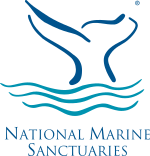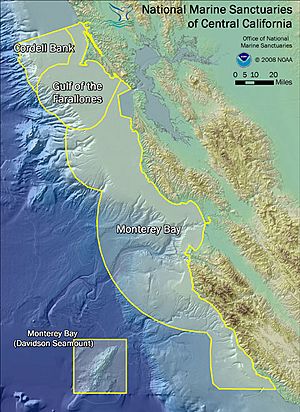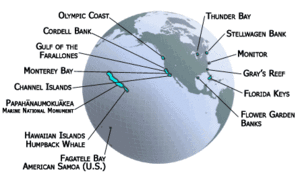United States National Marine Sanctuary facts for kids
 |
|
| Agency overview | |
|---|---|
| Formed | October 23, 1972 |
| Jurisdiction | United States federal government |
| Headquarters | 1305 East-West Highway, Silver Spring, MD 20910 |
| Employees | 350 |
| Annual budget | $50 million (2016) |
| Agency executive |
|
| Parent agency | National Oceanic and Atmospheric Administration |
A U.S. National Marine Sanctuary is a special underwater area in United States waters. These areas are protected to keep their amazing ocean environments safe and healthy. The program started in 1972 because people were worried about the health of our oceans.
These sanctuaries protect parts of the ocean that are important for many reasons. They can be special for recreation (like swimming or diving), for their unique animal and plant life, for their history or culture, or for scientific study. While people can still use these areas for many things, the main goal is to protect and restore the natural homes and populations of ocean creatures.
There are 14 National Marine Sanctuaries across the U.S. They cover a huge area, more than 783,000 square miles (2,028,000 km²)! Some are small, less than 1 square mile (2.6 km²), while others are very large, up to 583,000 square miles (1,510,000 km²).
The National Marine Sanctuaries Program (NMSP) is part of the National Oceanic and Atmospheric Administration (NOAA). This program manages all 14 sanctuaries. It began after a big 1969 Santa Barbara oil spill in California. This event made people realize how much our ocean ecosystems needed help. In response, the United States Congress created the Marine Protection, Research and Sanctuaries Act in 1972. This law allowed for the creation of marine sanctuaries.
These sanctuaries protect many different things. They include coral reefs in places like American Samoa, Florida, Hawaii, and Texas. They also protect old shipwrecks in the Great Lakes and the Atlantic Ocean. The Papahānaumokuākea Marine National Monument is another huge protected area. It's not a sanctuary, but it's also managed by the NMSP, along with other groups.
Contents
What Do Marine Sanctuaries Protect?
Being a National Marine Sanctuary does not mean all activities are automatically stopped. For example, recreational and commercial fishing is allowed in some sanctuaries. However, rules can be put in place to limit activities that might harm the ocean.
Sometimes, other government groups also help enforce rules in sanctuaries. For instance, fishing rules in Stellwagen Bank are set by NOAA Fisheries, not directly by the NMSP. These rules help protect the ocean environment. Groups like the Marine Conservation Institute have information about what activities are allowed or restricted in each sanctuary.
How Are Sanctuaries Chosen?
Choosing a new marine sanctuary is a careful process. NOAA, a government agency, leads this work.
Finding Special Ocean Places
First, teams of marine scientists look for important ocean areas. They try to find places that represent different parts of the marine environment. These places are then considered as possible new sanctuaries.
Working with Local Communities
Next, NOAA talks with state leaders and local communities. They want to know if there is interest in protecting these areas. If everyone agrees, the potential sites are then looked at more closely. This involves getting feedback from the public and from lawmakers.
Making It Official
NOAA then creates a plan for managing the new sanctuary. They also prepare a report about how the sanctuary will affect the environment. Public meetings are held to gather comments from people. After reviewing all feedback, the Secretary of Commerce, with the President's approval, officially names the area a National Marine Sanctuary. Even after this, Congress or the state governor can still object to the decision.
List of U.S. National Marine Sanctuaries

Here are the current U.S. National Marine Sanctuaries:
- Channel Islands National Marine Sanctuary (Pacific)
- Cordell Bank National Marine Sanctuary (Pacific)
- National Marine Sanctuary of American Samoa (formerly Fagatele Bay) (Pacific)
- Florida Keys National Marine Sanctuary (Atlantic, Gulf of Mexico)
- Flower Garden Banks National Marine Sanctuary (Gulf of Mexico)
- Gray's Reef National Marine Sanctuary (Atlantic)
- Greater Farallones National Marine Sanctuary (formerly Gulf of the Farallones) (Pacific)
- Hawaiian Islands Humpback Whale National Marine Sanctuary (Pacific)
- Mallows Bay National Marine Sanctuary (Atlantic)
- Monitor National Marine Sanctuary (Atlantic)
- Monterey Bay National Marine Sanctuary (Pacific)
- Olympic Coast National Marine Sanctuary (Pacific)
- Papahānaumokuākea Marine National Monument (Pacific)
- Stellwagen Bank National Marine Sanctuary (Atlantic)
- Thunder Bay National Marine Sanctuary (Great Lakes)
Future Sanctuaries
One area that might become a sanctuary in the future is:
- Lake Michigan National Marine Sanctuary (Great Lakes)


